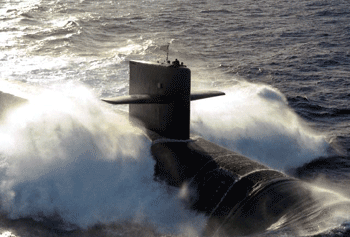 Description: Nuclear-powered submarines armed with long-range strategic missiles.
Description: Nuclear-powered submarines armed with long-range strategic missiles.
 Description: Nuclear-powered submarines armed with long-range strategic missiles.
Description: Nuclear-powered submarines armed with long-range strategic missiles.
Background: Strategic deterrence has been the sole mission of the fleet ballistic missile submarine (SSBN) since its inception in 1960. The SSBN provides the nation's most survivable and enduring nuclear strike capability. The Ohio class submarine replaced aging fleet ballistic missile submarines built in the 1960s and is far more capable.
Ohio-class/Trident ballistic missile submarines provide the sea-based "leg" of the triad of U.S. strategic deterrent forces. The 18 Trident SSBNs (each carrying 24 missiles), carry 50 percent of the total U.S. strategic warheads. Although the missiles have no pre-set targets when the submarine goes on patrol, the SSBNs are capable of rapidly targeting their missiles should the need arise, using secure and constant at-sea communications links.
Features: The first eight Ohio class submarines (Tridents) were originally equipped with 24 Trident I C-4 ballistic missiles. Beginning with the ninth Trident submarine, USS Tennessee (SSBN 734), all new ships are equipped with the Trident II D-5 missile system as they are built, and the earlier ships are being retrofitted to Trident II. Trident II can deliver significantly more payload than Trident I C-4 and more accurately.
The Ohio-class submarines are specifically designed for extended deterrent patrols.
To decrease the time in port for crew turnover and replenishment, three large logistics
hatches are fitted to provide large diameter resupply and repair openings. These hatches
allow sailors to rapidly transfer supply pallets, equipment replacement modules and machinery
components, significantly reducing the time required for replenishment and maintenance.
The class design and modern main concepts allow the submarines to operate for 15+
years between overhauls.
The first four Ohio-class submarines are scheduled for conversion over the next five years to guided missile submarines (SSGN) with an additional capability to transport and support Navy special operations forces.
Point of Contact:
Public Affairs Office
Naval Sea Systems Command
Washington, DC 20362
 Return to the Fact File Table of contents.
Return to the Fact File Table of contents.